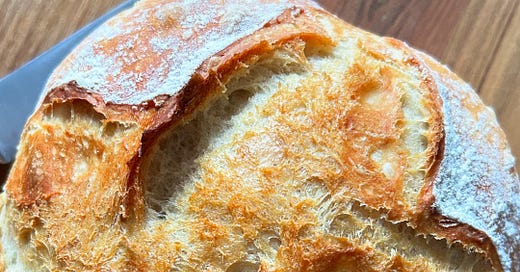Welcome to the first instalment of Artisan Bread 101, a new series where we’ll dive into the core elements of bread making. Think of this as your foundation—in the coming weeks, we’ll explore things like yeast, flour, water, salt, temperature, tools and scoring. No matter your level, these are the essentials every baker should know before starting to bake artisan bread.
This may seem obvious, but bread making is about more than a recipe. It is a process that is flexible, adaptable and creative and there are no fixed rules. There are so many variables involved in bread making that can affect the outcome—even the elevation where you live can have an impact. To some extent, it really depends on what works well for you, and that can take time and practice.
Some of my favourite bakers and authors are still learning and continuing to evolve as part of this never-ending journey. Each time, with every loaf, we get better and better. The good news is that homemade bread will almost always be better, healthier and more sustainable than store-bought versions. Even when our loaves are a little flatter or denser than we’d like, the bread we make is our reward and it will taste delicious!
The elements I will be covering are all things I’ve learned over time. I am always working to hone my skills and still tweaking my method. Sometimes it’s to make the process more sustainable, other times it’s to test new tools or to incorporate things I’ve learned from other bakers. Often, it’s just because I think I can make my recipes even better. If you’ve followed me on social media for a while, you will know that I added an additional, game-changing step to my artisan bread method early last year. All my artisan bread recipes have been updated to include this step, so no matter which one you’re looking for, you will have the latest.
One of my goals with this Substack, and with Harvest & Nourish in general, is to share what I’ve learned. In this case, so you can bake your own artisan bread with confidence and experience the tremendous joy that comes with bread making. This series is intended to answer some of your FAQs and provide tips and insights that are based on my own personal experience. You may or may not agree with some of them, so please read with an open mind. I am beyond grateful to be part of this bread loving community and always happy to hear your feedback!
Today, we’re starting with an introduction to artisan bread. Despite a recent resurgence in interest in artisan bread making in general, I’ve found that many of the questions I receive are the result of bakers not having a clear understanding of what artisan bread is. In today’s post, we’ll cover:
What is artisan bread?
The difference between yeasted artisan breads and sourdough
What you’ll gain from baking artisan breads
Why artisan breads are better for you
You can find my Everyday Artisan Bread recipe here.
Today’s post is for paid subscribers, who also get full access to my archive, in-depth newsletters like this one and exclusive perks, including early access to recipes. If you choose to upgrade to a paid subscription, your support helps keep this newsletter going and allows me to expand my content offerings. Thank you!





